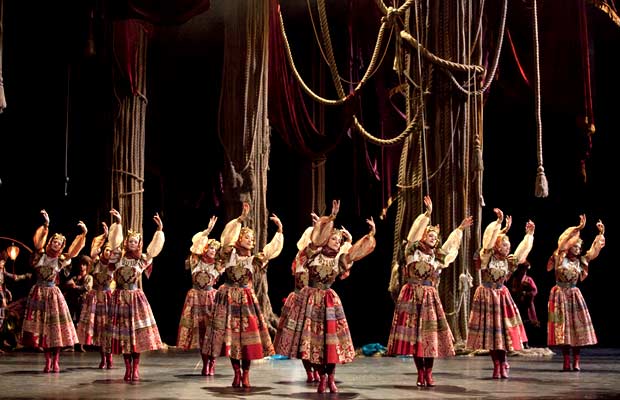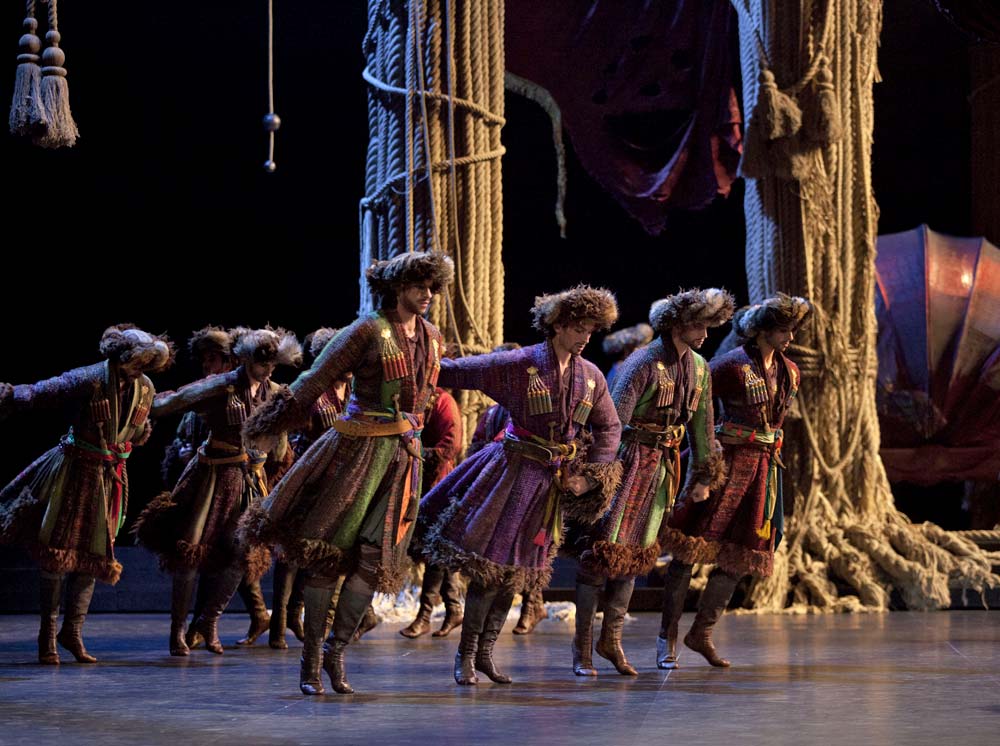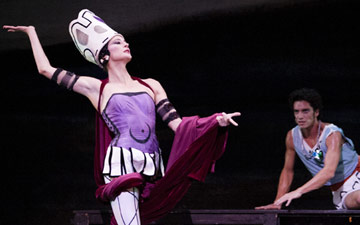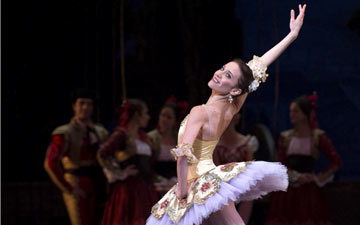
© Anne Deniau. (Click image for larger version)
Paris Opera Ballet
La Source
Recorded at Palais Garnier on 4 November 2011
US HD cinema broadcast on 26 August 2012
www.operadeparis.fr
www.balletincinema.com
We’re lucky in New York that we frequently see Balanchine’s charming La Source, and so get to enjoy its marvellous score by Leo Delibes, made almost entirely out of the bits he wrote for the eponymous and long-lost ballet created by Arthur St. Leon for the Paris Opera Ballet in 1866 (and lasting only a couple of decades in the repertory). It’s among the most lilting and danceable ballet music extant, and a worthy precursor to his Sylvia and Coppelia. If Jean-Guillaume Bart’s shiny new staging for the POB, broadcast live to theaters around the world in high-definition video last Sunday, did nothing more than provide the occasion for Delibes’ glorious score once again to impel the dance and delight the ear at the Palais Garnier, it would have been enough. If Bart’s ballet had done that, and also given us cause to see Christian Lacroix’s brilliant costume designs come to life, it also would have been enough. But Bart’s a gifted and discerning artist, with a deep understanding of the Opera’s heritage and style. Rather than trying to “recreate” the long-forgotten original choreography by Arthur St. Leon, Bart’s made a new work that feels old, as if it had long been a warhorse of the Opera’s repertory, subject to over a century of vagaries in taste and technique, yet emerging today all the richer for the experience, and eloquent of its history.
And if La Source’s patina of tradition is really no more than well-crafted trompe-l’oeil, what of it? It’s really good trompe-l’oeil. A ballet choreographed last year can’t embody a historic environment of over a century, as with a really good production of Swan Lake (if you can find one). In La Source, then, Bart can’t show us the past as it actually was, but, with a sensibility that feels very Parisian indeed, he’s presenting, not the past as it might have been, but the past as he, or rather, the POB’s artistic gestalt, chooses it to have been. He’s that good. His La Source, then, despite its silly plot, speaks of a decades-long evolution in style from Romantic to Classical no less wonderful for the fact that it doesn’t exist, except, perhaps, in the exactitude of Bart’s imagination and the Parisian dancers’ sinews.
La Source, however well staged, is not an unalloyed joy, which might account for its long absence from the POB stage. Alloy No. 1 is that ubiquitous purveyor of melodies both forgettable and you-wish-they-were, Ludwig Minkus, who shared the composing duty with the younger and less experienced Delibes. It is safe to assume that any part of the score through which you’re not actually napping is by Delibes. Alloy No. 2 is Charles Nuitter’s libretto, in which the plot is propelled forward by the leads’ flaws as much as their virtues. Among the ranks of dimwitted and narcissistic 19th-Century ballet heroes (that is, all of them), Djemil the hunter stands out as exceptionally dimwitted and narcissistic. The two heroines, Naila the water nymph, and Nouredda, the Circassian princess, are not themselves the sharpest pencils in the box.
What the story does accomplish nicely is provide reasons to bring onstage three of the 19th-Century ballet’s favourite populaces: supernatural women in white tutus, exotic Eurasians in awesome boots, swathed in furs and scowls, and, of course, harem girls. I wrote a recap of the story, such that it is, but cut it out, because, really, who cares? (If, for some reason, you do, I’ve appended it as a postscript.) As the overture played, I noticed the curtain at the Garnier was painted to look like a mass of billowing red fabric, braced with artfully dangling gold tassels, which rose to show the first scene’s desert setting, which was, oddly enough, masses of billowing red fabric hanging from the ceiling, braced with artfully dangling gold tassels. For a dreadful moment, I worried that all the cordage was meant to represent some sort of “backstage” setting, but I soon saw the logic of Eric Ruf’s minimal designs (the second scene’s palace is equally spare): they don’t compete with Christian Lacroix’s elaborate, stunning costume designs.

© Anne Deniau. (Click image for larger version)
Among the ropes and tassels, four men in blue tights, jerseys and body paint leap and gambol about; apparently they’re elves, as they’re soon joined by their leader, Mathias Heymann, similarly attired and painted, but in green, as Zael (listed in the program as the elf of Naila, the water nymph we’re soon to meet). Heymann flits over the stage with dazzling, intricate feats of batterie; he’s one of those dancers with such natural ballon and elevation that at times it seems his feet touch the stage more as a pro forma nod to the technique of mere mortals or, perhaps, the better to mark the music. Ever-smiling and fey, he looks every inch a creature of magic. Upstage, female nymphs, attired much as Degas ballerinas, appear; while the aerial elves practice their petite allegros, the ladies wander about with a dreamy, exaggerated version of the “ballerina walk,” in which with each step their heel only touches the floor a minute behind, and a foot inboard, of their toes.
Soon we have the entrance of Karl Paquette’s Djemil, the hunter, who, in his nondescript, faded brown leggings and jacket, appears to be a poor and unsuccessful one, perhaps because he’s left home without a single weapon. Loping about the stage in one big jump after another – unlike Zael, Djemil is a saute-de-basque kinda guy – he looks less a hunter and more a handsome blond surfer dude untroubled by care or coherent thought, an impression aided by Pacquette’s marked resemblance to the actor Jeff Daniels of a decade or so ago (if they ever make a Dumb and Dumber ballet…). The fun’s soon interrupted by the arrival of the large entourage of Circassians, who, according to the program, stop to rest on their way to bring the beautiful Nouredda to her marriage with the Khan of Ghendjib. This being one of those ballets, “rest” means “engage in one bravura character dance after another.”
Here’s our first look at the combined genius of Bart and Lacroix, and it’s stunning. The Circassian men are both exotic and fierce, with huge, fur-brimmed hats, fur-trimmed robes, and fabrics rich with patterns of gold against brown. The knives protruding from their belts, and rows of cartridges over their chests bespeak manliness almost as much the rich moustaches they all affect. These designs could well have been taken from some compendium, contemporary to La Source‘s late nineteenth-century creation, of the world’s most striking traditional costumes. The detail work seems near-photographic, and it’s a sensuous experience just to gaze upon Lacroix’s work. This goes double for the women, whose red boots complement the mens’ black ones, swathed in skirts, blouses and vests, the patterns of whose gold-and-brown fabrics outshine the men’s, as does the rain of gold coins that surround their headscarves.

© Anne Deniau. (Click image for larger version)
Lacroix has one veritable coup du theatre. The Circassians are all in earth colours: browns, oranges, gold, maroon. When Isabelle Ciaravola’s Nouredda is revealed as her chrysalis-like sedan chair splits open, she’s in skirts and scarves of brilliant aquamarine, and the sudden appearance of this contrasting colour is like a thunderclap against our retinas. I don’t think I’ve ever seen colour used onstage to such dazzling effect, and clearly Lacroix has a deep understanding of fabric, colour and, most importantly, the human eye.
Bart’s character dances are likewise stunning, and in them you can see touches of authentic folk dancing (I’m reminded of the Georgian troupe that came through New York several years ago), and other zesty forebears. Amidst the turned-in kicking and stomping, the men might leap and mime cracking an invisible whip, and suddenly it’s Polovtsian Dances and The Fountain of Bakhchisarai, except they perform every step with the POB’s perfect unity, in perfect lines and perfectly symmetrical. The facility and power of the POB dancers, even when packed together like well-accoutered sardines, is, as always, breathtaking. The women’s dances are more delicate, with those red-booted feet returning always to a turned-in, parallel position.
Christophe Duquenne does a bang-up job as Mozdock, Nouredda’s brother, leading the men with appropriately fiery passion, and, then, partnering Ciaravola in a sweetly exotic pas de deux. I liked how Nouredda’s pointe-work kept the folk-dance character, with feet more often parallel than turned-out, and more about grace than technique. Echoing Ciaravola, Duquenne would rise to a high half-toe, as if Bart stopped just shy having him go fully Georgian by dancing entirely on his toes. Even in repose, the Circassians would arrange themselves to look like figures from lithographs of old ballets; details like these, and the scrupulously-presented character dances, add to this ballet’s new-old feel.
After Djemil shimmies up one of the hanging tasselled ropes to retrieve for Nouredda the inconveniently situated flower to which she’s taken a fancy, he makes the faux pas of lifting her veil, which offends her, and earns him a well-deserved beating from Mozdock and friends. They depart, and we finally have the arrival of Ludmila Pagliero’s Naila, radiant in a gloriously designed tutu which quotes the plush style of La Source‘s time, but reworked for today, when we like both our ballerinas and their dress to look neither stuffed or upholstered. So, the fabric draped delicately about the hips of Pagliero’s Romantic skirt hints delicately at the bunting of yesteryear, as does the diaphanous scarf floating over her back. While I must confess to finding Ciaravola’s dancing a bit dry and cold for an ostensible love interest, Pagliero’s phrasing was far more musical and even, appropriately, juicy.
For the obligatory ballet blanc, where an amazed man must drift in amazement among a horde of near-identical, supernatural women, Naila calls on her subsidiary nymphs to entertain the easily-astonished Djemil. Here, Bart puts on a show indeed, marshalling the Opera corps about like dainty cavalry, and I was again thrilled by their extraordinary blend of unity and power. Bart loves to have his corps coalesce into the spokes of a wheel, with, just for fun, half spinning clockwise, half counter, so we can admire the ease with which their ranks pass through each other. Showoff. The speed at which these dancers can bring order out of, well, not chaos, but other orders, just astonishes. With a company style that seems to consider it hopelessly vulgar for an étoile to cut loose, the task of true bravura falls to the corps, and they certainly deliver. Bart gives us stage-spanning chorus lines (not unlike Balanchine) of eight or ten girls, and sends them hurtling merrily downstage at us, not with pretty emboites, but big jumps and saute de basques, all the more amazing for the Rockettes-like unity with which the line of near-identical girls nonchalantly dash them off.

© Anne Deniau. (Click image for larger version)
In his ensemble-work, Bart quotes, or rather borrows, devices from period ballets, but reworks them so they look like something a choreographer back the day might well have created. A very good one, as Bart’s work here is far more than pastiche, and never has that not-quite-reconstituted feeling of Pierre Lacotte’s work. In one pretty section, Pagliero leaped downstage along a diagonal of corps girls, each turning from facing upstage to down as she passed, as if her passage was pulling a long, white wave. It’s a similar device to the deadly diagonal along which the Wilis dispatch Hilarion, and gives us a frisson of recognizing the familiar made new.
Ruf’s set for the gardens of the Khan’s palace are similarly spare as the desert scene, and it’s also just as well, since Lacroix’s costumes command and deserve our undivided scenic attention, particularly the saffron pantaloons, blouses and hats of the many harem girls who harry the somewhat henpecked Khan (Alexis Renaud). Bart has great fun with the great dynamic contrasts in Delibes’ melodies, having the harem snap to respectful attention at an impatient gesture of Renaud’s as the horns thunder, only to dissolve into a cloud of gossiping, importuning gnats the instant he turns his back. His favourite, Dadjé (Nolwenn Daniel), after a cheeky onstage costume change into a more ballerina-ish tutu (abetted by her servants), leads the harem in Delibes’ grande valse, such contagious music I found my own feet wanting to join in. It is hard to resist being charmed utterly, as the dancers pose prone onstage with their heads raised above folded arms, and one foot pointing saucily at the sky. This was about the time that I realized the big advantage (and perhaps the only one) Bart has over Alexei Ratmansky when it comes to recreating historic ballets: for all his skills (and they are many), Ratmansky will never be chic.
Bart arranges an unforgettably dramatic entrance for Nouredda in her wedding dress, lifted by her entourage so her feet never touch the ground, even as they flip her, as if she’s flying, through a slow somersault before depositing her gracefully at the Khan’s feet. Bart saves his best for Naila, especially the long solo after her entrance. As Delibes’ phrases here contrast delicate, almost pizzicato sections with increasingly grandiose replies, Bart gives Naila little taquete steps building to larger turns or developpes. For Pagliero, the most musical dancer onstage, these were like candy to a baby, her witty feet easily matching Delibes’ charm. At the end of Naila’s adagio with the Khan, to some truly thunderous chords, Pagliero fairly hurled herself into Renaud’s arms, finishing in a dramatic, near supine pose, one arm drifting towards the stage, as if she’d been caught only at the last moment.
In La Source‘s final scene, back in the desert, the ballet’s unfortunate chickens come home to roost: the story’s silly denouement and Minkus’ tin ear for drama make for a finale that’s frustratingly unworthy of its preceding glories. At this point, none of the lead characters are particularly sympathetic. Djemil is a hopelessly selfish lover, Nouredda’s even more the standoffish bitch she’s always been to him (not without reason), and Naila is too stupid to live, as she soon demonstrates. Bart does his best here, but he’s stymied at every turn by Minkus’ relentlessly dull music. A long duet between a man in love with a woman who wants none of him is not exactly what we want to see at this point in a ballet, yet such is Djemil’s with Nouredda, who, mercifully for all involved, succumbs, albeit too briefly, to the vapors. It’s hard to get emotionally behind Naila here, either. While I suppose it’s a necessity of the genre that the heroine in tulle or feathers not actually survive until the final curtain, Naila’s self-sacrifice, compared with Giselle’s or Odette’s, is pointless. Once she’s declared her intent to kill herself so that Nouredda and Djemil might dance happily ever after as impoverished hunter and wife (and mazel tov to that), yet before she can get on with it, she must dance a solo to Minkus’ typically perky beer-garden drivel. Bart and Pagliero do their mightiest to make it look like the triumph of Naila’s will over her (very sensible) reluctance, but it’s as if Odette were to dance a polka on the cliff’s edge. By the time she finally does die, it’s a relief (no more Minkus, and we can all go home).
The preceding notwithstanding, I’d see this La Source again in a heartbeat. If the unfortunate last scene is the price one must pay for the brilliance of the preceding two, it’s a small one, and that’s what aisle seats are for.
—oOo—
La Source Synopsis
by Eric Taub
Somewhere in Persia, Nouredda, a beautiful Circassian princess, is on her way, along with her brother Mozdock and a large entourage, to marry the Khan of Ghendjib. They stop by a stream, and a hunter, Djemil brings her a hard-to-reach flower (good), then, impulsively, lifts her veil uninvited (bad), which is incredibly stupid, given the ratio of Djemils (one) to ferocious relatives and countrymen of Nouredda (lots), who then proceed to give him the inevitable thrashing. Fortunately, a local water nymph, Naila appears. She promises to help Djemil win the love of Nouredda, perhaps not the smartest move, considering she’s in love with Djemil herself. So, with the company of Naila’s elves (I swear I’m not making this up), led by Zael, they all head off for the palace of the Khan.
At the palace, the poor Khan is fighting off the attentions of his harem girls. Dadjé, his “favourite” (a job in which there is apparently little security) tries to win the attention of the Khan by (surprise!) dancing for him, which is about as effective as you’d imagine, given he’s waiting for the arrival of his bride-to-be. Nouredda and Co. enter, and the Khan dances, entranced, with her. The incognito Djemil and the elves arrive, then Naila, who knows how to make a grand entrance, and the Khan dances, entranced, with her. She has no difficulty in convincing him to dump Nouredda, who leaves the palace in disgrace (the program notes say she’s been “freed,” but apparently nobody told her). With all the emotional intelligence Djemil’s shown so far, it’s no surprise that he follows after, looking to catch her on the rebound. Classy guy. Back at the stream, Nouredda is having none of Djemil’s attention (think of how much less she’d like him if she finds out he’s responsible for ruining her marriage). Naila bubbles up through the ground (I mean trap door), after, I assume, dumping the Khan (whose marriage, remember, she’d also just ruined, making, at least, Dadjé happy).
Naila confesses to Djemil that she loves him, but nonetheless offers to use her water-nymph skills to compel Nouredda to love him, even though currently Nouredda doesn’t even like him. Naila adds the small detail that if she does this for him, she’ll die. Of course, Djemil tells her to go ahead. (Dude, you’ve got a beautiful, magical nymph in love with you, and you dump her, fatally, for a woman whose life you’ve ruined?) She procures a flower much like the one from the first act, and, after a moving solo to the finest Minkus oompah, leads Djemil to the supine form of Nouredda, who’s collapsed from the horror of it all. She drops the flower on Nouredda, who wakes and dances an appropriately banal romantic adagio with Djemil. They depart, arm in arm, towards the happy future awaiting them upstage, as Naila, fatally deflowered, expires in a graceful puddle at Zael’s feet.

















Compelling review, now you made want to watch it. Just one tiny correction though, the staging of Giselle was done by Patrice Bart while La Source was by Jean-Guillaume Bart their only common attribute was they both used to Etoile of POB.
Eric, your gloriously written review makes me feel as though I had been sitting next to you in the cinema. Thank you
Thanks, Al and Janet!
Yes, Al, I confess to getting my Barts confused. Also, the casting information handed out at the theater was apparently not updated with a change due to injuries (they only had ten months to do so!). The review has been updated to remove mentions of Patrice Bart’s Giselle, and to fix the casting. Ironically, the qualities I admired in Patrice’s Giselle, especially the attention to detail and “historical” affect, were also there in JG’s La Source. But, had I realized they were not, actually, the same person (by checking something obscure like their first names), I wouldn’t have mentioned it, and so, best just to take it out.
My thanks to all the Internet people who pointed out my Bart mistake, and the casting error!
Talking about Bart’s attention to detail, apparently he already started to develop La Source since 2006 based on this interview that I found (said he’s no Lacotte) http://www.augustevestris.fr/spip.php?page=article1&id_article=79
It was very interesting to read his opinion about hyper extension, pointe technique (he prefers English pointe technique), on creating new ballet, US male class that he attended, etc.